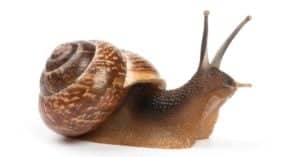Snails are widely considered one of the slowest animals in the world. Like most gastropods, they do not have legs and instead use a muscular ventral foot for movement. Their lack of legs is likely to blame for their slowness, especially when compared to the speed of humans.
In this article, we discuss how fast snails move, their top speeds, and how these speeds compare to that of humans.
How Do Snails Move?

Most snail species move by crawling with a mucous-covered foot.
©Marko Blagoevic/Shutterstock.com
There are over 40,000 different species of snails living in various habitats around the world. Each species has a unique appearance, lifestyle, and method of moving. Although most of us are familiar with terrestrial snails that slither with a mucous-covered foot, some snails can jump and even swim. The way a snail moves could affect how fast they move. Snails that jump or swim are usually faster than those that simply crawl.
Crawling
Crawling is the most common way for snails to move. It is used by both terrestrial and aquatic snails. Garden snails are a great example of a popular snail that moves by crawling.
They have a foot muscle that creates wave-like contractions that allow the snail to crawl from one place to another. Their soft foot muscle is covered with epithelial cilia and mucous that helps snails stick to different surfaces and prevent their foot from drying out.
Most snails have a single ventral foot, but species such as the Pomatias elegans, or simply round-mouthed snails, have a divided foot. They tend to crawl faster than single-footed snails in a motion similar to walking with two feet.
Jumping
Jumping is another way for certain snail species to move. Conch snails are a good example of snails that can jump by using their operculum. Most conch snails will dig their operculum into the substrate to pull themselves forward, creating a jumping motion with each pull.
The humpback conch snail (Gibberulus gibberulus) has a unique survival strategy that involves jumping away from predators. These snails use their muscular foot to jump as much as their body height to escape to safety. This survival response is usually triggered by the presence of toxic predators, such as cone snails.
Swimming or Floating
Certain sea snail species, such as violet snails or sea butterflies, have adapted to swimming. Violet snail is the common name for two marine species Janthina globose and J. janthina. These snails do not necessarily swim by themselves and instead create a mucous bubble that allows them to float in the water.
How Fast Do Snails Move?

The average snail moves at a speed of 0.03 miles per hour (0.048 kilometers per hour).
©Molnar Sebestyen/Shutterstock.com
How fast a snail moves depends on their species. Also, most snails will move at a faster speed when they feel threatened.
The typical speed of some popular snail species, such as garden or Roman snails, is 0.029 miles per hour. This makes the average speed of most snails about 0.03 miles per hour or 0.66 inches per minute, with a few exceptions. The giant African land snail moves at a speed of 0.2 miles per hour or about 6.5 feet per hour.
Amber snails are believed to move at a speed of 0.08 inches per minute, while whelks from the Atlantic Ocean move at about 6.4 inches per minute. Pond snails (Lymnaeidae stagnalis) commonly move at speeds of 4.8 inches per minute.
Aquatic snails are generally faster than most terrestrial snails. Despite their small size, bladder snails can move remarkably fast in search of food or to evade predators. The average speed of a bladder snail is approximately 8 inches per minute.
Snails that jump or swim are considerably faster than their crawling counterparts. Conch snails are known to leap faster when they detect cone snails in the water. Some people compare their jumping speed as similar to humans, but possibly faster when they want to evade predators.
How Does a Snails Speed Compare to Humans?

Most humans are about a hundred times faster than the average snail.
©Master1305/Shutterstock.com
The average human walks at a speed of about three miles per hour, although it can vary amongst individuals. This is much faster than the average speed of most snails at 0.03 miles per hour. The average walking human could be more than a hundred times faster than both terrestrial and aquatic snails. Fast snail species that can jump or swim are still slower than the average human even if they are motivated to move faster because of predators or food.
It could take a snail up to 100 hours to travel three miles if they maintain a speed of 0.03 miles per hour.
Final Thoughts
Snails are known for their slow pace, which is much slower than the average human walking speed. Although most snails move at a speed of 0.03 miles per hour, several species are faster, reaching 0.7 miles per hour. Regardless of how they move or their top speed, a snail is very slow compared to a human.
The photo featured at the top of this post is © Master1305/Shutterstock.com
Thank you for reading! Have some feedback for us? Contact the AZ Animals editorial team.







